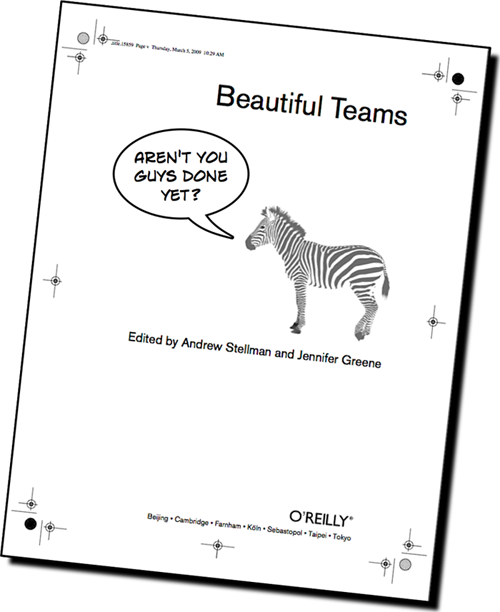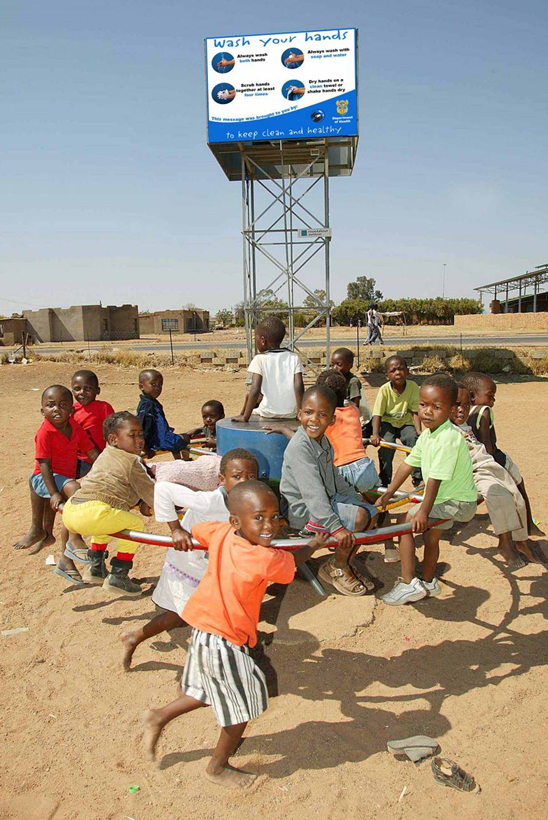
Beautiful Teams is finally on its way to the printer!
For those of you who have been wondering why our blog posts slowed to a trickle over the last six months, now you know. Jenny and I have been working pretty steadily on Beautiful Teams, and we’re both really happy with how it came out.
Here’s a — well, it’s not really a sneak preview. It’s more like the promo copy we came up with for the back cover:
What’s it like to work on a great software development team facing an impossible problem? How do you build an effective team? Can a group of people who don’t get along still build good software? How does a team leader keep everyone on track when the stakes are high and the schedule is tight?
Beautiful Teams takes you behind the scenes with some of the most interesting teams in software engineering history. You’ll learn from veteran team leaders’ successes and failures, told through a series of engaging personal stories — and interviews — by leading programmers, architects, project managers, and thought leaders.
Looking back over the project, I’m pretty amazed at how much I learned about how teams work — from an incredible group of people, many of whom I’ve admired and looked up to for most of my career. Here are just a few:
- Scott Berkun wrote a great essay called “Why Ugly Teams Win” — and he did an incredibly insightful interview with Steve McConnell where they talked about the kinds of practices that make teams work
- Barry Boehm — and his longtime colleague, Maria Penedo — wrote a fascinating story about one of the first software process improvement projects ever
- Grady Booch talked to us about how he creates a better team culture
- Karl Wiegers, whose books gave me my first grounding in software requirements enginering, wrote a wonderful story about one of his early experiences with using use cases on a project
- Cory Doctorow — and, mind you, I think I’ve actually got a paper copy of Boing Boing lying around somewhere! — contributed a story about a team of IP activists
- Scott Ambler talked to us about the kinds of obstacles teams face, and how he works to get past them
And that’s just the beginning.We have over thirty contributions from people all around the software industry (and a few very insightful ones from people who aren’t in our industry at all!).
Now that I’ve got a little time to post again, I’m sure I’ll be telling you more about the lessons I learned, not just from actually writing and editing the book, but from the wealth of knowledge and experience all of our contributors shared with us. I’ve already started applying that newfound knowledge to my own teams and projects.
Oh, one more thing — my favorite part of the project! Not a single one of our contributors asked to be paid. Instead, they donated their time and considerable expertise to this project. Instead, we’re contributing royalties from the book to PlayPumps International, a truly wonderful charity that digs wells and installs pumps to deliver clean drinking water to rural schools and villages in sub-Saharan Africa.

One reason I love PlayPumps is that it’s more than a charity — in a way, it’s a major civil engineering organization in its own right. And PlayPumps does what they do in a unique way: by driving the pumps with merry-go-rounds or roundabouts, which the children in the village play on. Not only does this give them clean water, it also frees up women, who in many villages have to literally spend
their entire day fetching water, often from polluted sources. We had the privilege of interviewing Trevor Field, the founder of PlayPumps, not just because he does great work, but because he does it through great innovation, engineering, and teamwork. That interview is one of my favorite chapters in the book.
Okay, so I hope I was able to write this post without turning it into too much of a marketing piece. Stay tuned, and with a little luck you’ll see much more frequent updates now that the book’s out the door.
